-
Call Us:1.800.561.4019
Newsletter
For a Free Quote...
Latest Blog Posts
Blog Categories
Telnet Network News
SDN and Network Management: Infosim® StableNet® Current State of Affairs and Roadmap
Dr. David Hock, Senior Consultant R&D, Infosim®, discusses how Infosim® StableNet® is integrating SDN and Network Management to increase the benefits for their customers.
Recently, Software Defined Networking (SDN) has become a very popular term in the area of communication networks. The paradigm shift introduced by SDN is a promising enabler for many use cases. However, it also opens up a lot of new challenges for Network Management Software Providers. Infosim® is working together with customers, SDN experts, and academic researchers to extend network management systems to cover SDN.
Software Defined Networking (SDN)
The key idea of SDN is to introduce a separation of the control plane and the data plane of a communication network. The control plane is removed from the normal network elements into typically centralized control components. The normal elements can be replaced by simpler and therefore cheaper off-the-shelf devices that are only taking care of the data plane, i.e. forwarding traffic according to rules introduced by the control unit. Today’s most popular realization of SDN is OpenFlow developed by the Stanford University around 2008.
The approach of a centralized control plane brings several benefits, including, among others, reduced investment costs due to cheaper network elements, and a better programmability due to a centralized control unit and standardized vendor-independent interfaces, as indicated in Figure 2. In particular, SDN is also one of the key enablers to realize network virtualization approaches which enable companies to provide application-aware networks and simplify cloud network setups.
However, despite of the benefits it brings, SDN also opens up new challenges. One of these challenges, particularly in the interest of Infosim® as one of the leading companies in the Network Management area, is how to integrate SDN into a traditional Network Management System (NMS). Typical parts of an NMS, such as configuration and monitoring, need to be revised and adapted to include the technologies of SDN.
Necessary extensions to include SDN in Network Management Systems (NMS)
Two main tasks of a Network Management System are configuration and monitoring. Figure 1 illustrates a state-of-the-art network managed by StableNet®. Regarding the monitoring, the NMS asks for configuration and performance information via standardized protocols, such as SNMP, WMI, IP-SLA, or Netflow. The configuration of different network entities is usually done in a centralized way using the unified Infosim® StableNet® interface. However, this includes a lot of different backend proprietary protocols which a network management vendor has to support and maintain.
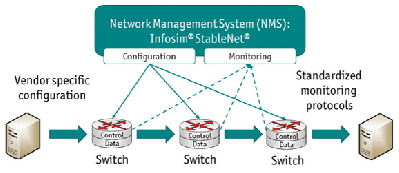
In non-SDN environments, the network configuration is separated from the network control. The centralized control approach introduced by SDN, however, enables new possibilities to integrate network management functions into the network control. That way new use cases are possible:
(1) With integrating NMS information into the network control, e.g. legacy network, information can be made available to an SDN controller that can then be used to support routing decisions.
(2) With integrating SDN information into an NMS, the functionality of the NMS can be increased, including e.g. the discovery of an SDN topology or new passive monitoring approaches enabled by SDN.
Integrating SDN and StableNet®
SDN is becoming more and more popular and a steadily rising number of SDN devices can already be bought. Therefore, we expect that for many of the Infosim® customers the importance of SDN will heavily increase in the next years. Having this in mind, Infosim® is aiming at being one step ahead of the crowd and integrating SDN and StableNet® already now.
New mechanisms are needed and already implemented by Infosim® that allow the configuration of SDN-based networks. The challenge here is that SDN networks are still in development and you need an agile development approach to cope with the changes. Requirements to these mechanisms include device management, bootstrapping, operational configuration, security, the coverage of mixed environments, and many others.
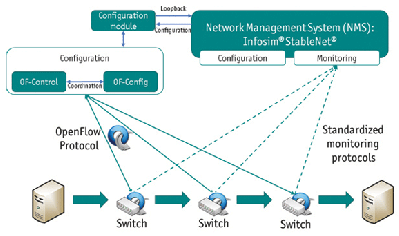
Figure 2 illustrates how an integration of SDN and Infosim® StableNet® is realized. In Infosim®‘s concept of an SDN and Infosim® StableNet® integration, a bidirectional communication of Infosim® StableNet® and SDN controller is possible. This way both, the NMS and the SDN world, can profit from each other by having access to additional information that would not be available elsewise.
One of the provided extensions is integrating the configuration of SDN controllers, e.g. OpenDaylight, including e.g. the definition of flow table rules, directly in StableNet®. Another extension is the inclusion of performance counters to monitor SDN flows. The actual standards do not offer this capabilities directly and you need an extension that is provided by Infosim®. Figure 3 shows example screenshots of the described extensions.
Figure 3: Example screenshots of the Infosim® StableNet® SDN module
(a) Integrated configuration approach

(b) Monitoring approach using OpenFlow Statistics and an own controller module to communicate with Infosim® StableNet®
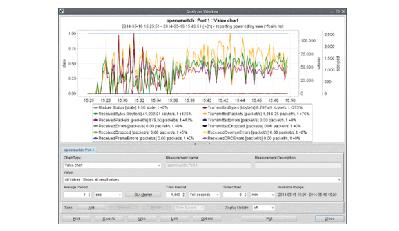
Ongoing SDN extensions to StableNet®
We are continuously fulfilling our efforts to map the current state of technology into StableNet®. Together with different SDN experts and academic researches, Infosim® is also taking part in bleeding edge projects to look at the SDN-development and future SDN use cases to extend Infosim® StableNet® by promising features enabled by SDN.
One key driver to successfully implement SDN networks is the availability of a service catalogue. The idea of a service catalogue is to provide a holistic view on any service in a network including all involved entities, such as network components, servers, and user devices. An example is illustrated in Figure 4.
Figure 4 Infosim® StableNet® Service Catalogue to provide a holistic view on services including all of the involved components and devices
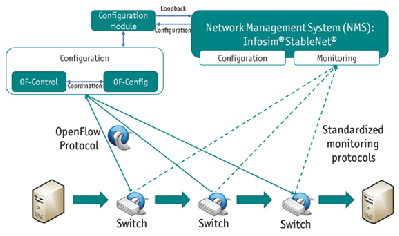
Different colors indicate various services currently running in the network as well as the entities involved in these services. Offering a holistic, aggregated view on these services enables the generation of a service matrix that enormously facilitates different NMS tasks, including, e.g., configuration or SLA monitoring.
In a time where green computing is more and more discussed, the concept of network virtualization makes it very appealing to subsequently replace physical hardware devices by virtual software instances. SDN is a very promising enabler for such an approach. Another popular term that is frequently named in this context is Network Functions Virtualization (NFV), where certain network functions are virtualized and provided on commodity hardware. Often, a large economy of scales can be reached by aggregating different services as virtually separated instances on a single physical infrastructure. However, this approach also brings new security implications regarding the isolation of different services in a virtualized network infrastructure. Some of these security issues are currently targeted by Infosim®:
(1) In the age of smartphones and tablets, it is more and more common that employees of a company bring and use their own devices in the company’s network. If a physical separation of the company’s production network and the network where the mobile devices are connected to is not feasible, network virtualization is a promising alternative to separate the different types of traffic in the network. However, to guarantee the security of sensitive data in the company’s network, the isolation of the virtualized networks has to be guaranteed.
(2) A similar challenge arises when various services with different security requirements are run as virtual instances in a single physical network. Again isolation has to be guaranteed to assure that no security SLAs are violated.
Infosim® StableNet® is already extended with SDN capabilities. We are continuously working to integrate new SDN technology into our product such that a smooth transition to SDN or a mixed operation of SDN and non-SDN networks is possible.
About StableNet®
The Infosim® StableNet® unified management solution provides a complete all-embracing multi-functional management wrap around your entire infrastructure enabling consistent End-to-End management, resulting in faster resolution (MTTR), smarter operational management through lower operating costs, seamless support, flexibility in scaling and provisioning a changing environment to meet new business products and developments, providing for a great customer experience and service differentiation.
The Infosim® StableNet® solution is a flexible service provisioning and service assurance multifunctional platform that provides customers with a much broader range of capabilities that include:
- Asset Management
- Configuration and Compliance Policy Management
- Fault & Event Management (with Root-Cause Analysis RCA)
- Performance & Capacity Management
- Visualization
- Lifecycle Management (EOx)
- Vulnerability Management
Thanks to InterComms for the article.
When you subscribe to the blog, we will send you an e-mail when there are new updates on the site so you wouldn't miss them.




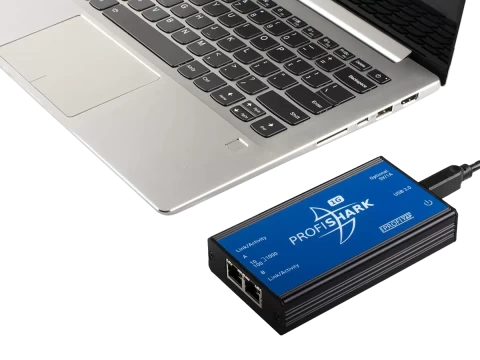
Comments